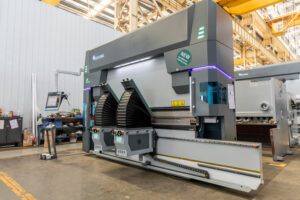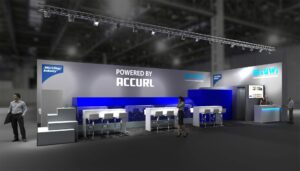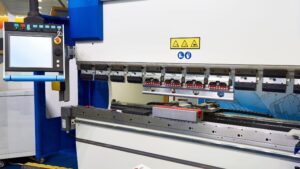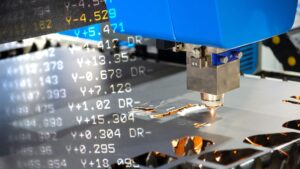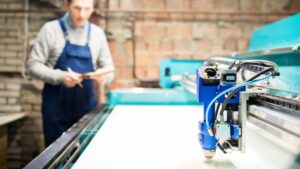Much like the revolutionary shift brought by fiber laser cutting technology in the realm of sheet processing, press brake bending has its own tales of advancements and nuances.
It’s a technique intrinsic to metal fabrication and holds paramount importance, transforming simple sheets into intricate and functional designs. Let’s navigate through the detailed intricacies of press brake bending, drawing parallels from the world of laser technology to accentuate the nuances of this bending technique.
The Fundamentals of Press Brake Bending
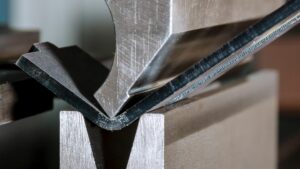
Press brake bending is to metal fabrication what the resonator is to laser technology. Essentially, press brake bending is a process that molds sheet metal into specific shapes by exerting force through punches and dies. This method is indispensable in the manufacturing and production sectors, turning raw metal sheets into functional components.
Understanding the Different Types of Press Brakes
Press brakes come in diverse variants, each boasting its own set of benefits. Much like the different types of laser generators, each type of press brake serves a unique purpose:
- Hydraulic Press Brake: Renowned for its versatility, it’s powered by hydraulic oil and two synchronized hydraulic cylinders.
- Mechanical Press Brake: Defined by its flywheel, crank mechanism, and clutch, it offers rapid and efficient bending.
- CNC Press Brake: Powered by computerized operations, this brake offers precision and programmability.
Key differences:
- Power Source: Hydraulic oil versus mechanical force versus computerized controls.
- Precision: CNC press brakes generally offer more accurate results.
- Speed: Mechanical press brakes are often faster than their hydraulic counterparts.
Techniques and Methods in Press Brake Bending
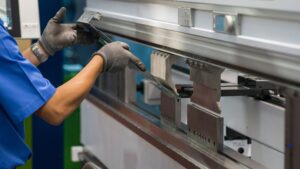
In the world of press brake work, techniques are as varied as laser beam paths. Some methods ensure precision; others prioritize speed:
Understanding Bottoming
At its core, bottoming, also termed as bottom bending, is where the sheet metal is forcibly pressed down to the very bottom of the die. This technique is marked by:
- High Force Application: Unlike some methods, bottoming exerts substantial pressure to ensure the metal firmly reaches the die’s base.
- Precision: Given the nature of the method, it produces highly accurate bends, especially when the material thickness is known and consistent.
- Bend Deduction Calculations: These play a pivotal role in bottoming, as they account for the springback and determine the actual bend angle.
Air Bending: Elegance in Simplicity
Air bending, a favorite among many operators, has the metal resting on the die while the punch descends, achieving the desired bend. Its key attributes include:
- Variable Bend Angles: Since the sheet metal never contacts the side walls of the die, various angles can be achieved with a single V die opening, giving operators significant flexibility.
- Less Force Required: Compared to other techniques, such as coining, air bending requires less force, making it a popular choice for hydraulic press brake machines.
- Dependence on Material Properties: Material type, thickness, and grain direction greatly impact the final result.
Coining: Sculpting Metal to Precision
The coining method is a testament to the brute force capabilities of press brakes press machines. Here, high force is applied, making the metal conform to the exact shape of the die.
- Dimensional Accuracy: Coining ensures the sheet metal mirrors the punch and die’s shape with impeccable precision.
- Reduced Springback: Given the force exerted, metals tend to have reduced springback, leading to more consistent results.
- Demands on the Machine: Due to the high bending force required, the machinery’s longevity may be at risk if not properly maintained.
Diving into Three-Point Bending
Three-point bending stands out for its predictability and consistency. In this method, the punch and die have three contact points that ensure an unwavering bend.
- Consistent Bend Radius: This method is renowned for offering a stable bend radius irrespective of the variations in material thickness.
- Efficiency: The process saves time, given that the punch doesn’t descend entirely onto the workpiece.
- Less Wear on Tooling: Given the controlled nature of three-point bending, tools and dies exhibit reduced wear over time.
Rotary Bending: Thinking Outside the Box
A deviation from traditional methods, rotary bending employs rotating tools rather than stationary punches and dies.
- Reduction in Surface Scarring: The metal’s movement against the rotating tool decreases the chances of surface marring.
- Increased Speed: The method’s efficiency is especially noticeable when handling complex bends or large batches.
Folding: Doubling Up
Folding involves bending the metal back onto itself. This method is not just about the bend, but also the overarching mechanism that facilitates it.
- Diverse Material Handling: Given its nature, folding is versatile, aptly handling varying material thicknesses and types.
- Precision: The precision of a fold is often determined by the back gauge, its positioning, and the CNC controller guiding the press brake operation.
Tooling Essentials in Press Brake Bending
Just as the quality of a laser beam is vital in laser cutting, the tools in press brake bending are crucial for desired outcomes:
- Punches: These are the upper tools that press the metal sheet into the dies.
- Dies: The lower tools that give shape to the metal as the punch exerts force on it.
- Backgauges: Devices that position the metal sheet accurately for the bend.
Common Mistakes in Press Brake Bending and How to Avoid Them
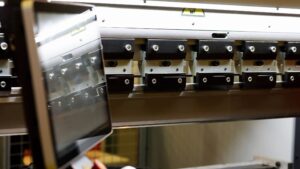
Errors in bending are akin to laser beam power losses; they can be detrimental. Here are some frequent mishaps:
Over-bending: The Extreme Bend Dilemma
Over-bending happens when excessive force is applied during the press brake work. It’s comparable to the laser beam power losses mentioned earlier; too much power, in this case force, can be counterproductive.
Bending sheet metal needs precision. The thickness of the material, the type of metal, and the desired bend angle all play a role in determining the appropriate force. When over-bending occurs, it’s often because of:
- Bending Force Miscalculations: Incorrect estimation of the bending force required based on material thickness and bend radius.
- Lack of Knowledge: Not understanding the bending methods suitable for the specific metal being used, like air bending or bottom bending.
- Inaccurate Equipment Settings: Not setting the press brake machines correctly according to the workpiece’s requirements.
It’s paramount for operators to be adept at understanding the nuances of their machines and the materials they’re working with. By ensuring the right amount of force application and frequent recalibrations of the machine, over-bending can be minimized.
Tooling Troubles: The Importance of Correct Tool Selection
Just as selecting the wrong resonator can negatively impact laser work, choosing the wrong punch and die can hamper press brake results. The punch and die’s role in press brake bending is akin to that of the laser in cutting; they define the work’s precision and quality.
A single mistake in tool selection can lead to:
- Deformation: Incorrect tools can distort the sheet metal’s shape, leading to waste and rework.
- Inconsistency: Different metals and material thicknesses require varying tooling considerations. Using the same tool across the board leads to inconsistency in results.
One way to mitigate these issues is through CNC controller integration. Modern press brake machines often come with a CNC controller, which aids in tool selection based on input parameters like material type, thickness, and desired bend angle. By leveraging technology, the chances of tooling errors reduce significantly.
The Springback Surprise: Accounting for Metal Memory
Metals, especially common ones like carbon steel used in fabrication processes, have a tendency to revert slightly after bending. This phenomenon, known as springback, can throw a wrench in the expected results of press brake work.
Understanding springback involves:
- Material Ductility: Some metals, due to their ductility, are more prone to springback. Recognizing these properties aids in anticipating the degree of springback.
- Bending Methods: Techniques like coining or air bending have varying degrees of impact on the workpiece, influencing its springback tendencies.
To counteract springback, operators should make allowances for this natural reversion. Predictive tools and technologies, combined with operator experience, can ensure that the final bend angle and shape match the desired specifications.
The Essence of Handling: Safeguarding Material Integrity
Proper material handling is pivotal to maintaining the quality of the sheet metal during the bending process. Think of sheet metal like the sensitive surface of a laser’s lens; any mishandling can lead to irreversible damage.
Press brake operation relies on:
- Safe Material Movement: Using mechanisms like back gauges to position the sheet accurately under the press brake ram.
- Protection from External Factors: Ensuring the worktable and tools are free from debris, oil, or any other factors that can cause surface defects.
The Importance of Consistency: Force Application and Results
Applying inconsistent bending force is like having varying power in a laser beam – the results will be unpredictable. For press brakes to produce consistent bends, the application of force should be even across the workpiece.
Factors influencing this include:
- Machine Calibration: Regularly calibrating press brake machines ensures they deliver the right force throughout the bending process.
- Operator Training: Ensuring operators understand the importance of even force application and are trained to notice inconsistencies.
Safety First: Never Overlook Protocols
Much like any other machinery in metal fabrication, press brakes come with their set of risks. Overlooking safety protocols isn’t just a cardinal sin in press brake operation; it can lead to severe injuries.
Essential safety considerations:
- Emergency Stop Button Accessibility: Ensuring the button is within easy reach and functional.
- Regular Maintenance: Keeping the press brake and its components in top condition to avoid sudden failures.
- Operator Training: Ensuring every operator understands the machine’s safety features and the importance of adhering to protocols.
Essential Safety Protocols in Press Brake Bending
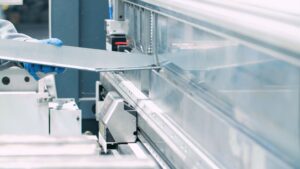
Just as we prioritize laser safety, pressing metal sheets with tons of force necessitates stringent safety measures. A well-maintained brake is like a well-calibrated laser, minimizing risks:
Importance of Proper Training and Certification
It’s no secret that trained and certified operators produce better results. When dealing with hydraulic press brakes and the bending of sheet metal, expertise is vital. The intricacies of understanding the bending process, from the bend radius to the material thickness, play a crucial role in the final product.
- Knowledge of Different Machines: Operators should be familiar with different types of press brakes and their capabilities.
- Understanding Bending Methods: From air bending to bottom bending, a trained operator knows which method to apply for optimal results.
- Material Insights: Recognizing the differences in metals and their properties ensures appropriate force application during bending.
The Value of Regular Machine Maintenance
Just like a finely-tuned instrument, press brake machines require regular attention. Consider the parallels between a CO2 resonator and a press brake. Both demand meticulous care to deliver their best performance.
- Ensuring Longevity: Regular check-ups can significantly increase the longevity of the machinery.
- Preventing Downtime: Maintenance identifies potential issues before they become larger problems, saving valuable production time.
- Guaranteeing Precision: Keeping press brakes in top condition ensures bending accuracy and consistency.
The Imperative of Personal Protective Equipment (PPE)
Press brake operation is not without its risks. Hence, the importance of PPE cannot be stressed enough. Each piece of equipment has a specific purpose and provides protection against various potential hazards associated with press brake work.
- Shields: These are crucial in protecting the operator from flying debris and potential mishaps during bending.
- Safety Glasses: Essential to protect the eyes from any small particles or fragments that might break off during the bending process.
- Gloves: They ensure that the operator’s hands are protected from potential cuts, heat, and other hazards.
Maintaining Clear Work Zones
In the intricate world of metal fabrication, clarity and organization are paramount. The work zone around press brakes should be free from unnecessary items that could impede the bending process or pose a hazard.
- Preventing Mishaps: A clutter-free zone reduces the risk of accidents caused by tripping or materials falling.
- Enhancing Efficiency: A well-organized work zone speeds up the workflow, as tools and materials are easily accessible.
- Reducing Waste: By ensuring everything has its place, waste is minimized, enhancing overall efficiency.
Significance of Proper Material Handling
Materials, be it carbon steel sheets or other metals, must be treated with care. The manner in which they’re stored and transported can profoundly impact the final product.
- Safety in Storage: Materials should be stacked in a manner that ensures they won’t topple over or become damaged.
- Efficient Transportation: Use mechanisms like trolleys to transport heavy sheet metal, reducing the risk of injuries.
- Preserving Material Quality: Proper handling ensures that the metals retain their quality and are free from unwanted dents or deformations.
Factors Influencing Bending Accuracy
Achieving the perfect bend is akin to the precise laser cut. Many parameters influence the end result:
- Material Type and Thickness: Different metals and their thickness can affect bend angles.
- Grain Direction: The orientation of metal grains can affect the bend’s outcome.
- Tooling Condition: Worn-out tools can reduce precision.
- Operator Skill and Experience: Mastery and experience lead to better results.
Tips for Optimizing Press Brake Operations
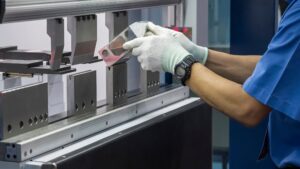
Here’s how you can enhance your press brake tasks, drawing parallels from optimizing laser operations:
Importance of Proper Calibration
The hydraulic press brake, like its peers, necessitates regular calibration. Proper calibration ensures the bending process is accurate, with factors like bend angle and bending radius duly considered. Precision in these parameters is paramount for quality results, minimizing errors and wastage in materials.
- Calibration Challenges
- Bend Deduction Calculations: Ensuring the correct formula is used based on material and desired bend.
- K Factor Considerations: This value, representing the neutral axis position, must be right for accurate bending.
Keeping Tools Sharp and Clean
Maintaining the punch and die is central to consistent press brake work. Dull or dirty tools compromise the quality of the bends and may affect the bending force required. A keen focus on tool maintenance promotes longevity and reliable results in every project.
Tool Maintenance Essentials:
-
- Wear Inspection: Regularly checking tools for signs of wear can preempt many pressing issues.
- Cleaning Regimen: Removing metal residue, oil, and debris prevents bending problems and ensures the longevity of the tools.
Avoiding Overloading the Press Brake
Every press brake has its operational limits, defined by tonnage and material thickness it can handle. Exceeding these capacities doesn’t only jeopardize the machine and results but also poses risks to the operator.
- Signs of Overloading
- Vibrations: Unusual machine vibrations can be indicative of undue stress.
- Metal Deformations: When the metal doesn’t bend as expected or has inconsistencies, it may be a sign that the machine is overloaded.
- Emergency Stop Engagements: Modern machines may have safety measures like emergency stop buttons that activate under overload.
Utilizing Updated Software and Technology
The advent of technologies like CNC controllers has transformed press brake operation. By ensuring your machine is equipped with the latest software and technology, you optimize speed, precision, and versatility in your bending tasks.
- Benefits of Updated Tech
- Enhanced Precision: With advanced software, bending angle calculations, bend allowance considerations, and other parameters are more accurately processed.
- Reduced Waste: Optimized processes mean less material waste and rework.
- Operator Ease: Modern systems often simplify tasks, making it easier for the operator to deliver quality results consistently.
Costs Associated with Press Brake Bending
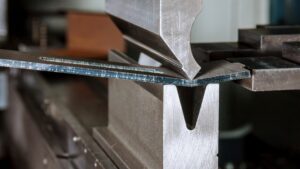
Setting up and running a press brake has its expenses, much like operating laser machines:
- Initial Investment: Costs of buying the machine and setting it up.
- Operating Costs: Daily expenses related to power, materials, and manpower.
- Maintenance Costs: Regular upkeep and replacement of worn-out parts.
- Training and Certification Expenses: Cost of training personnel for optimal operation.
Alternatives to Press Brake Bending
As there are other cutting techniques besides lasers, there are also alternatives to press brake bending:
- Roll Forming: A continuous bending operation for long pieces of metal.
- Tube Bending: Ideal for cylindrical workpieces.
- Stamping: Uses dies to shape metal via high pressure.
- Rotary Draw Bending: Uses a rotating form to shape the metal.
Conclusion
Press brake bending is a versatile, precise, and efficient method for shaping metals, just as laser technology has revolutionized sheet cutting. Both domains, though distinct, exemplify how understanding the machinery’s nuances, its capabilities, and the factors affecting its performance can lead to superior results.
Whether you’re bending metal or cutting it with a laser, knowledge is power, and understanding the intricacies can significantly elevate your manufacturing prowess.


